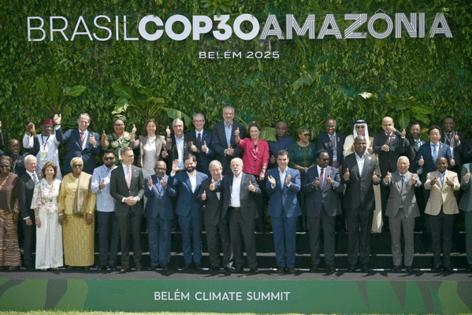California steps in as Trump skips global climate summit in Brazil
Published in News & Features
LOS ANGELES — Nearly 200 nations are gathering this week in Belém, Brazil, to kick off the annual United Nations climate policy summit, but there is one glaring exception: The Trump administration is not sending any high-ranking officials.
California hopes it can fill in the gap. The state, as it usually does, is sending a large delegation to the Conference of the Parties, including first-time attendee Gov. Gavin Newsom and top officials from the California Natural Resources Agency, Department of Food and Agriculture, Air Resources Board, Public Utilities Commission and Governor’s Office of Tribal Affairs.
The state aims to build on its reputation as a global climate leader, sharing its experience with clean energy technology and job creation and showcasing its track record of climate agreements with other countries and regions.
Newsom, who is positioning himself for a 2028 presidential run, told The Times he “absolutely” sees California as a proxy for the U.S. at this year’s conference, which is the main global venue for countries to strengthen their commitments to reducing greenhouse gases.
“California has a responsibility, but also a unique opportunity at this moment, to remind the world that we’re here, that we believe these issues matter, and that there’s an opportunity here to reinforce existing alliances and develop new ones,” the governor said.
California’s strong presence at COP also marks an escalation of Newsom’s ongoing battle with President Donald Trump. The two have clashed over immigration and climate, with the president’s energy and environment agenda often targeting the state. The Trump administration this year canceled funding for major clean energy projects such as California’s hydrogen hub and moved to revoke the state’s long-held authority to set stricter vehicle emissions standards than the federal government.
But this year’s Nov. 10-21 gathering also comes at a critical moment for the world. It’s the 10th anniversary of the Paris Agreement, a seminal treaty signed at the 2015 COP in which world leaders established the goal of limiting global warming to 3.6 degrees Fahrenheit (2 degrees Celsius) above preindustrial levels, and preferably below 2.7 degrees F (1.5 degrees C), in order to prevent the worst effects of climate change.
Most experts and scientists agree that the 2.7 degree target is no longer within reach. The last 10 years have been Earth’s hottest on record, driven largely by greenhouse gas emissions that come from the burning of fossil fuels.
“One thing is already clear: We will not be able to contain the global warming below 1.5 degrees [C] in the next few years,” U.N. Secretary General António Guterres said at a recent gathering of the World Meteorological Organization. “The overshooting is now inevitable.”
The U.N.’s annual Emissions Gap report released in conjunction with the conference finds that without immediate and aggressive action, the world is on track to warm between 4.14 and 5.04 degrees (2.3 and 2.8 degrees Celsius) over this century.
Yet Trump withdrew the U.S. from the Paris Agreement on his first day back in office, a move he also made during his first term as president. In a January executive order he stated that the Paris Agreement and other international climate compacts pose an unfair burden on the U.S. and steer American dollars to other countries.
The U.S. withdrawal from the Paris Agreement is expected to add an additional 0.18 degree to the latest warming projections, in effect nullifying a small gain made since last year, the U.N. report says. It notes that every fraction of a degree of warming means more losses for people and ecosystems, higher costs to adapt, and more reliance on uncertain techniques to remove carbon from the atmosphere.
However, the report underscores that the technology to deliver big emissions cuts already exists, pointing to booming developments in wind and solar energy, much of which is occurring overseas.
It’s a sector where California can lead, Newsom said, adding that the Trump administration has “doubled down on stupid” by ceding so much ground to China. The Golden State has invested heavily in renewables, battery energy storage and the electrification of buildings and vehicles. California has also set ambitious decarbonizaiton targets and reduced its greenhouse gas emissions by 21% since 2000 while its economy has grown 81%.
“We want to continue to tip the scales, and this is about economic growth, this is about jobs, and this is about addressing the other crisis of our time: affordability,” Newsom said. “When you talk about energy efficiency, you’re talking about affordability. When you talk about wind and solar, you’re talking about abundance and you’re talking about affordability.”
California has already helped to spread a lot of real technology. The state’s aggressive emission rules were pivotal in pushing automakers toward electric vehicles, with Toyota largely developing its Prius for California’s market. The state was the first to mandate battery energy storage at its major utilities, helping jump-start the modern grid-battery market, while its cap-and-trade carbon market program has been emulated in places around the world.
State leaders hope to highlight more than their progress at home. In recent years, California has also forged subnational agreements and partnerships with other regions and countries on issues such as delivering clean transportation, cutting pollution and developing hydrogen and renewables. Newsom is expected to sign additional agreements at COP this year, although his team declined to provide a preview of what they will entail.
Among the state’s dozens of existing agreements are a memorandum with Mexico’s Baja California Energy Commission focused on clean ports, zero-emission transportation and grid reliability; and memorandums with several provinces in China on pollution reduction and offshore wind power. The California Department of Forestry and Fire Protection also has partnerships with several countries that are sharing resources and best practices for managing vegetation and combating wildfires.
Focusing on these actions at the state and regional level has become a key part of COP conferences as the conversation gains urgency and shifts to deployment, according to Rachel Cleetus, senior policy director at the nonprofit Union of Concerned Scientists.
“There is a whole other face of the United States — we have a lot of subnational actors, including leading states and cities and forward-looking businesses, who will be at COP showing the rest of the world that the United States does understand that it’s both in the interest of our country, as well as the global interest, to tackle climate change,” Cleetus said.
California’s delegation in Brazil also includes Natural Resources Secretary Wade Crowfoot, who represented the state at the Local Leaders Forum in Rio de Janeiro this week.
“This year, our federal government is totally missing in action ... and the rest of the world needs to understand that America is still in this fight, and we’re moving forward,” Crowfoot said in a briefing.
Crowfoot highlighted California’s carbon market partnership with Quebec and one with Denmark that yielded groundwater monitoring technology that California uses today, among other examples of international efforts.
This year’s COP conference, which is taking place near the Amazon River delta in northern Brazil, is heavily focused on forest restoration and nature-based solutions, which California also focuses on through its 30x30 program to conserve 30% of the state’s lands and coastal waters by 2030, Crowfoot said. The Golden State already has deep ties to the region stemming from its landmark 2019 Tropical Forest Standard program, which set guidelines on carbon credits awarded for reducing deforestation.
Newsom said that at COP, he will highlight climate action as the defining economic opportunity of the 21st century. He is slated to speak at the Milken Institute’s Global Investors’ Symposium, a gathering of leading investors and business executives, about how California shows that clean energy investments create jobs and profit. Green jobs now outnumber fossil fuel jobs in the state, 7 to 1.
“Were not just talking about this from the perspective of trying to be good citizens,” Newsom said. “We’re also trying to be competitive geopolitical players. We want to dominate in the next big global industry.”
Still, there is much work to be done.
Every five years, parties to the Paris Agreement are required to submit targets for their greenhouse gas emissions. The targets so far have “barely moved the needle,” according to the U.N. report, and the ones handed in this year aren’t nearly aggressive enough.
“It’s devastating to see that now we are definitely going to breach the 1.5 C benchmark,” said Cleetus, of the Union of Concerned Scientists.
“But world leaders still have the power to sharply cut these emissions,” she said.
©2025 Los Angeles Times. Visit at latimes.com. Distributed by Tribune Content Agency, LLC.







Comments